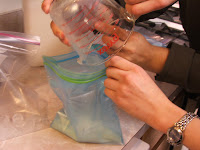Last week, three of your New Voices bloggers got together to try an at-home experiment...
Question
Can three highly educated bloggers make quick ice cream with ingredients found in a regular kitchen?
Hypothesis
Yes.
Materials

- 1 tablespoon sugar
- 1/2 cup milk or half & half
- 1/4 teaspoon vanilla
- 6 tablespoons rock salt
- 2 pint-size plastic bags
- 1 gallon-size plastic bags
- Ice cubes (about 4 cups)
- Measuring cup
- Gloves
- Safety goggles (you never know what might happen)
- Bowl
- Spoon
- Combine milk, sugar and vanilla. Stir until sugar is dissolved. (Trust us on the stirring, because we didn't.)
- Put ice cubes in large gallon-sized bag.
- Pour milk mixture into one of the small plastic bags. Seal with as little air inside as possible. Place this bag inside second small plastic bag. (This will help if the first one does not remain sealed.)
- Put the small bag(s) in the large bag with the ice.
- Pour salt over the ice and seal the large bag, trying to remove as much air as possible.
- Shake, toss, massage, etc. for 5 to 9 minutes, until ice cream thickens.
- Remove small bag from other bags. (Warning: outside bags are salty, do not cross contaminate. Again, trust us.)
- Enjoy.
 Everything's sealed in...
Everything's sealed in... Let's go!
Let's go! Shaking it up.
Shaking it up. End time.
End time. The outside of the two inside bags.
The outside of the two inside bags. The majority of our finished product.
The majority of our finished product.
Results
We did get some ice cream, but the inside most bag broke open, so it was really just a taste for each of us. Oh, and lots of sugar-vanilla-milk.
Conclusions
- The right materials are necessary to make quick and delicious homemade ice cream. For example, frozen peas and carrots will not, in fact, provide the same amount of exothermic energy as ice (read:frozen H2O), so make sure your roommates have not emptied the ice tray before beginning this experiment.
- Sugar-vanilla-milk is not as delicious as ice cream.
- Safety first helps to prevent very cold fingers.
Happy National Chemistry Week!


No comments:
Post a Comment